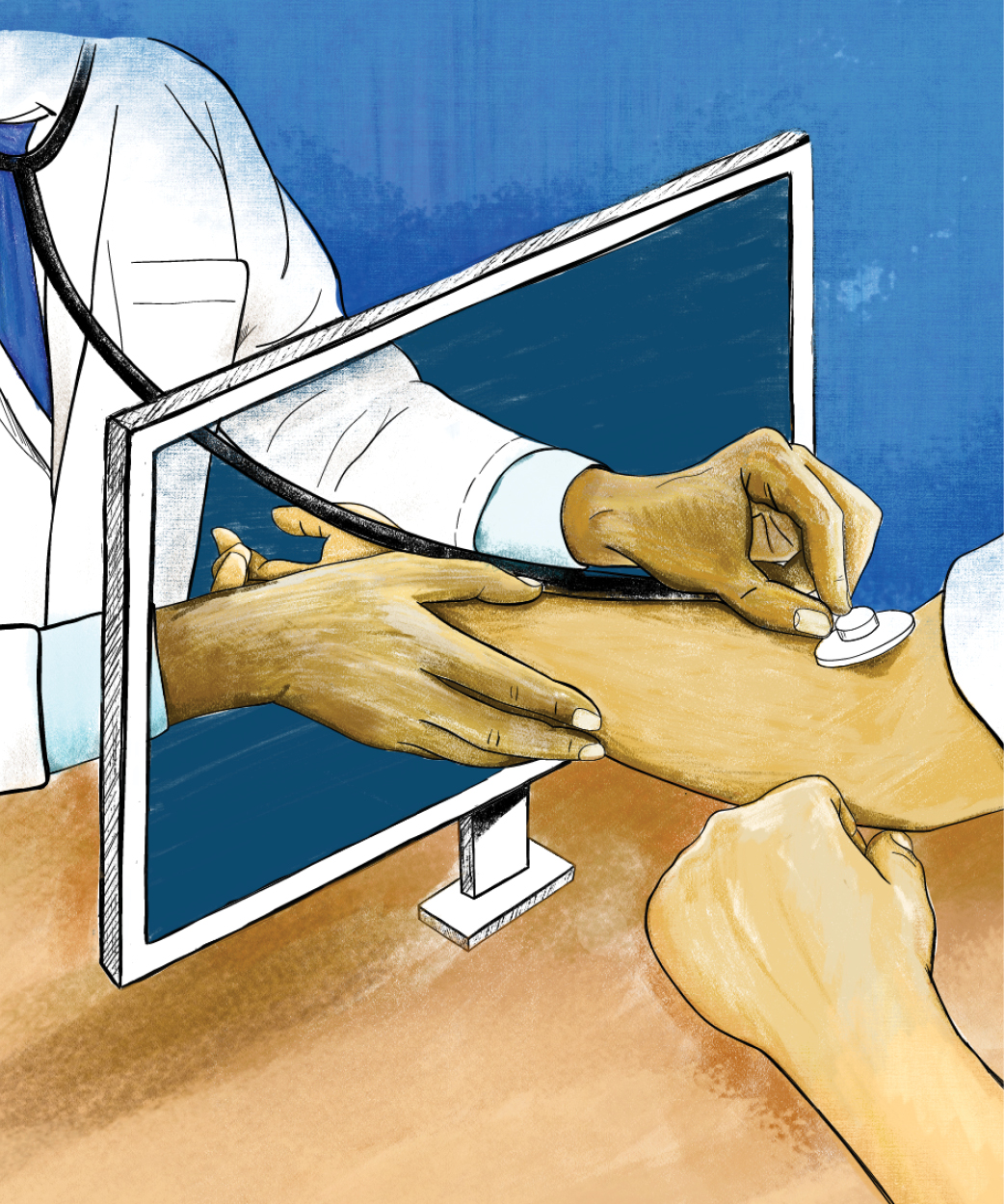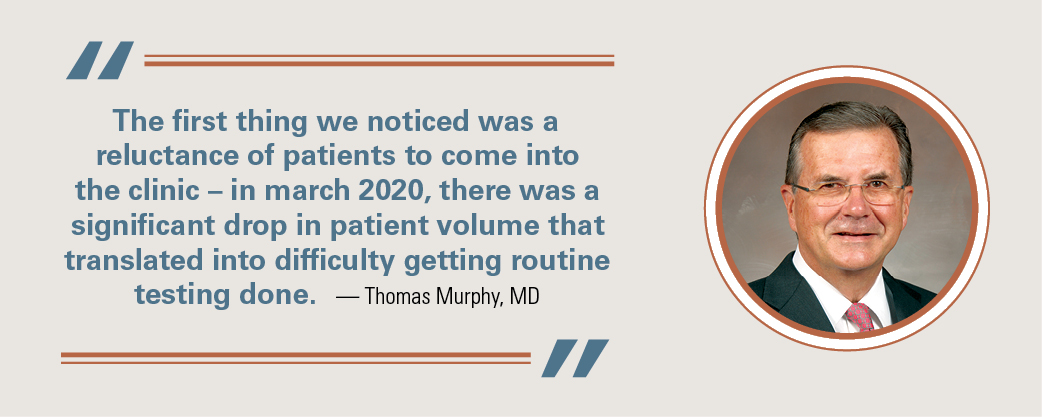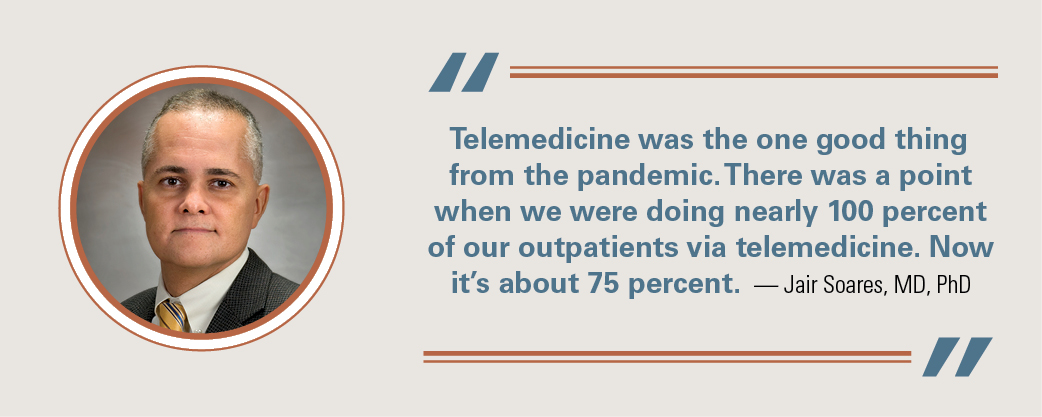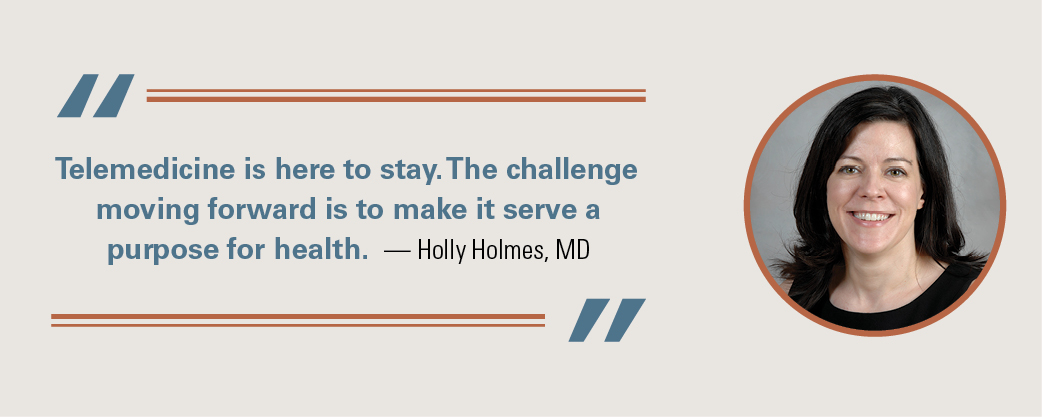The pandemic has forced each one of us to increase our reliance upon technology. McGovern Medical School has wholeheartedly embraced telemedicine; the online recruitment of students, residents, and employees; and work from home, thanks to a nimble Information Technology team and established infrastructure.
“Necessity is not just the mother of invention, it’s the mother of adoption,” said Amy Franklin, PhD, associate professor in the School of Biomedical Informatics. “The pandemic was a great impetus to push us over the threshold for those who were reluctant to adopt technology.”
Expanding Access
With the lockdown in 2020, UTHealth Houston employees and students shifted to remote access. UTHealth Information Technology scrambled to quickly quadruple access to the virtual private network (VPN), providing a digital lifeline from remote locations to work. “Prior to the pandemic, our high-water mark on VPN usage at the university was 400 users simultaneously – this was during a hurricane,” said Amar Yousif, CIO and vice president of Information Technology at UTHealth Houston. “Now we regularly have 4,000 concurrent users. It was really an overhaul.”
Meetings shifted to online with the ramp up of Webex and introduction of Zoom and Microsoft Teams.
“Before the pandemic, we could count the number of Webex meetings per day at the university on two hands,” Yousif said. “Now we have nearly 6,000 Webex meetings per week, which doesn’t include those who use Zoom or Teams for their virtual meetings.”
The quick switch to online meetings was not without challenges.
“In the early days, there clearly was a learning curve,” said Martin Citardi, MD, vice dean for Clinical Technology and chair of the Department of Otorhinolaryngology – Head and Neck Surgery. “Some of the learning curve was simply getting familiar with the software. But, the other part of the learning curve was related to meeting skills. Leading and participating in a virtual meeting is very different from the same tasks in an in-person meeting.”
The lockdown forced UTHealth IT to implement new work procedures. “We had to quickly adapt our helpdesk and IT Security procedures to support a workforce that now worked from their living room, the den, and the kitchen,” Yousif said, adding that IT fine-tuned its security measures, pushing out updates to include remote locations and shortening computers’ time-out screens.
On the hardware side, IT bought out 123 computers that were due to be returned on their lease. “We re-imaged them and made them available to employees who needed a computer to work from home,” said Bassel Choucair, associate vice president of Information Technology User Experience and Support.
Conference rooms throughout the Medical School were refitted to accommodate new technology. “Now people expect to be able to hear everyone in a room during an online meeting – not just a main speaker. We had to completely revamp conference rooms to treat them like a high-production television studio,” Yousif explained.
IT also ramped up its asset tracking process. “Tracking down hardware – computers, monitors leaving the building – everyone didn’t always let us know, and this was something we didn’t have to deal with before,” Choucair said.
Epic Times
Even though most employees and students were not on campus during the outbreak of the pandemic, IT learned to social distance while working onsite, breaking into sub-groups to limit contact on campus.
“As the pandemic started, we were starting the largest project in our IT history, migrating to a new electronic health record, Epic. As a result of this project, most of the MSIT staff needed to be onsite through the entire pandemic,” Choucair said.
IT stood up the new EHR while decommissioning the old one, providing access to more than 1,000 physicians and 150,000 patients.
“UTHealth Houston was one of the pioneering
organizations in the nation that had to carry out the bulk of the Epic implementation work in the middle of a global pandemic,” Yousif said. “We started the project in late 2019, did most of the heavy lifting in 2020, and successfully went live in May of 2021 earning 9 out of 10 Gold Stars at the time of go-live. It was a real testament to the grit of the UTHealth Houston community and their unwavering commitment to our mission.”
The pandemic’s many challenges did not slow the project.

“We still hit all of our timeline-to-implementation targets,” said Citardi, Memorial Hermann Chair. “In some ways, the switch to virtual helped us. We did not have to pay for travel from consultants, and it also allowed us to do back-to-back meetings for entire days; there was no lost time to switching rooms, etc. Physicians and clinical staff could participate in meetings sandwiched amongst their other prime responsibilities. And, the lack of face-to-face made everyone more comfortable because it took away the risk of COVID transmission.”
Turning to Telemedicine
The pandemic also erased challenges to telemedicine.
“The first thing we noticed was a reluctance of patients to come into the clinic – in March 2020, there was a significant drop in patient volume that translated into difficulty getting routine testing done,” recalled Thomas Murphy, MD, associate dean for Community Affairs and Health Policy. “Kudos to the government for stating telemedicine visits would be covered in this state of emergency.”
With a plan to roll out a telemedicine platform as a small pilot program in April 2020, UT Physicians quickly shifted to provide telemedicine to a broader scope of patients in March.
“Prior to March 2020, we had only dabbled in telemedicine, with some patients being seen in the Rio Grande Valley by our providers,” explained Stephanie Dixon, business analyst with UT Physicians Health Transformative Initiative (HTI) office, who led the telemedicine project. “To launch practice-wide, we had to think about how to conduct an office visit virtually, considering policies and best practices. It was a significant stretch, and we onboarded teams to support the technology and patients.
“UT Physicians very rapidly, almost overnight, set up a telemedicine hub staffed by physicians and advanced care providers who would tend to the phones and screen for patients who couldn’t access the clinic. The technology was existing, but we hadn’t used it to any great extent, and there were questions about who it should be used for and how it would be reimbursed.”
With the rapid introduction, improvement, and acceptance of telemedicine, the program ballooned to include 2,500 clinicians and clinical staff accessing the telemedicine platform and hosting about 5,000 virtual appointments per month.
“There was a lot of manpower that went into the support effort to standing up telehealth. We had over 60 training sessions, virtual and in person. It was a huge effort, and I really appreciate the HTI team stepping up to deliver this service,” Dixon said.
HTI office at UT Physicians targeted patient populations and specialties to increase their use of telehealth. “We had to rapidly become familiar with a technology we hadn’t used that much,” said Holly Holmes, MD, associate professor of geriatrics and Joan and Stanford Alexander Professor in Gerontology. “Every way we engage is a challenge for older people in general, and a lot of older people are not ready for telemedicine.”

Telemedicine, Yousif said, “went from a novelty to the way of seeing patients in one week.”
The Louis A. Faillace, MD, Department of Psychiatry and Behavioral Sciences had only “flirted” with telemedicine, prior to the pandemic, said Jair Soares, MD, PhD, chair of the department and holder of the Pat R. Rutherford, Jr. Chair in Psychiatry.
“Telemedicine was the one good thing from the pandemic,” Soares said. “There was a point when we were doing nearly 100 percent of our outpatients via telemedicine. Now it’s about 75 percent.”
Psychiatry expanded its telehealth presence, providing care to students at local school districts in and around the city of Houston and at the local Mental Health Authorities.
“The pandemic increased the demand for behavioral health services. It made things worse for those with existing mental health issues and brought along new mental health concerns that needed to be looked at. Telemedicine allows us to reach the patients where they are,” Soares added.
The Department of Family and Community Medicine rapidly ramped up the use of the telemedicine platform at the height of first waves of the pandemic. At the Harris Health Community Clinics, faculty first moved to a 100 percent telemedicine platform for appointed patients.
The platform has settled into its own niche, Murphy added, accounting for 15-20 percent of primary care visits now.
An early adopter of telemedicine, the Department of Neurology successfully rolled out the largest Artificial Intelligence-enabled stroke detection system in the region during the pandemic. “Partnering with Memorial Hermann, we have elevated our capacity to
care for patients throughout our 11-hospital network, by providing automated and immediate assessments of brain imaging to screen for patients that could benefit from stroke treatments,” explained Sean Savitz, MD, professor of neurology and holder of the
Professor and Frank M. Yatsu, MD, Chair in Neurology.
“Telehealth, especially if it continues to be reimbursed by the payers, is going to mature and become the norm for chronic disease management, mental health, and patients with minor symptoms. I predict that busy patients will demand more of it,” Yousif said.
Although older patients have been more cautious about exposure to COVID, many welcome the telemedicine option. “Don’t assume that older adults are afraid of technology – some people love it,” said Franklin, director of the Center for Digital Health and Analytics.
Psychiatry has seen a great adoption of the technology. “Our patients love it. Our work is really suited to telehealth platforms in that it eases access, helps patients be more compliant, and has worked well for routine checks and follow-up, and psychotherapy works great,” Soares said.
Murphy cautioned that telemedicine is not right for all patients.
“We noted early on that a lot of patients couldn’t navigate into a telemedicine experience – those with limited computer access or skills. We resorted to telephonic calls, but that’s inferior to a telemedicine visit, which is inferior to an in-person visit,” explained Murphy, holder of the Stanley Family Distinguished Chair of the Population Health and Community Medicine.
The goal, Holmes said, is to find the happy medium for telemedicine. “As it becomes an option, we have to figure out the most effective way to manage it for patients and clinicians,” she said, adding that nothing can replace the physical touch and attention of an in-person visit.
Franklin agreed, “We need to give the guideposts to help people make decisions. It’s our new world, and we have to figure out how to live in it.”
Accessible Education
Students were well prepared to shift to an all-virtual learning environment. “We were ready for the pandemic because we were already streaming our lectures,” explained LaTanya Love, MD, dean of education, ad interim.
To continue the educational mission for the clinical operations, IT created a virtual rounding solution using Webex and 35 iPads.
“This was done to preserve PPE that was in short supply and to allow our students to remotely participate in hospital rounding at a time when they weren’t permitted due to pandemic regulations,” Choucair explained.
The solution involved an attending physician “bringing in” trainees to the patient via a rolling stand outfitted with an iPad. “We had to create it in no time, but it worked,” Choucair said.
Student exams also moved to a virtual environment, and the offices of Admissions and Student Affairs and Educational Programs created an online proctoring solution. “We were able to virtually monitor students using Webex that was running on a ‘second device,’ such as their smartphone or iPad,” Choucair explained.
Educational opportunities, such as OrthoCamp2021, chaired by Milton “Chip” Routt, Jr., MD, Andrew R. Burgess, MD, Chair in Orthopaedic Surgery Trauma, evolved into a hybrid course accommodating an international audience of nearly 400 incoming orthopedic interns. Attendees tuned in to virtual lectures for didactics and then moved to an onsite skills lab at various locations.
New Standards
As a result of the pandemic, Choucair said the future of IT looks like “a lot more laptops and docking stations.” The downside to this shift, he added, is an increase in cost and the likelihood of asset loss, since laptops travel.
Meetings online and hybrid are here to stay at the Medical School. “This is why we refitted our key meeting rooms with higher quality microphones and cameras to support what we believe is a permanent change in the way meetings are conducted in the future,” Yousif said.
Flexibility is key, Yousif added.
“We are seeing the shift from society in general — workers are demanding more flexibility,” Yousif said. “The pandemic has been rough on people, and they reassessed their priorities, adjusted job scopes, and even retired. At the same time, we have seen a renewed dedication to work. There’s something unique about health care that rallied the staff around a more noble mission.”

UT Physicians’ telehealth option soon will be seamless within Epic, with plans to include remote patient monitoring for such measurements as blood pressure and glucose, provider-to-provider communication for consult, and e-visits, which allow patients to answer an online questionnaire that is then triaged to a provider for quick assessment and follow-up.
Patients are likely to see greater health integration in their online appointments. “We have the potential to pull in resources the patient needs while in a digital waiting room and provide the option for more patient-generated data to support the medical record,” said Franklin, associate dean of Student, Faculty, and Community Affairs at the School of Biomedical Informatics.
“Telemedicine is here to stay. The challenge moving forward is to make it serve a purpose for health,” Holmes said.